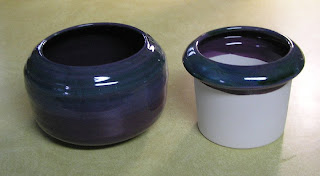
Healthy cyclamen plant.
Your plant is probably infested with cyclamen mites. These minute (less than 0.02mm in length), semi-transparent, greenish mites are too small for the naked eye to see. They hide in young, tender stem ends, leaves and flower buds of cyclamens (Cyclamen spp.) and many other indoor and outdoor plants. Their eggs are smooth and more apt to be found hidden in folds of plant tissue. They avoid light and prefer high humidity and cool (60 degrees F.) temperatures. They may be too small to see but their damage is obvious. Like all sucking bugs, these spider relatives cause wrinkled, curled growth and stunted flowers and foliage. Their damage first appears as light, speckled areas, which later spread over the entire leaf surface. Affected foliage turns yellow and eventually dies and drops off. Cyclamen mites can be a pest of garden strawberry plants and can be serious pests of a wide range of plants including: African violet, cyclamen, begonia, snapdragon, impatiens, gerbera, ivy, and many indoor tropical plants.
 Cyclamen leaf curling from cyclamen mite damage.
Cyclamen leaf curling from cyclamen mite damage.

Deformation on African violet caused by cyclamen mite damage.
Lifecycle. Cyclamen mites can complete their lifecycle in only 1 to 3 weeks depending upon conditions. Adults can over-winter out of doors as far north as Canada in protected locations and complete many generations a year.
There are several ways to handle this problem depending on how bad it is by the time you see the damage. If you catch them early, you can remove cyclamen mites from plants with a high-pressure stream of water. Spray the entire plant, especially the undersides of the leaves, with a jet from a hose. If that doesn’t work try some of the following tips.
1. Dispose of infested plants. Since these mites can be difficult to control and reproduce rapidly, disposing of infested plants is often the best solution to this problem.
2. Sanitation. Examine newly purchases plant in the spring and reject them if they have curled or deformed tips and shoots that may be signs of mites.
3. Heat treatment. Cyclamen are heat sensitive and can be killed if immersed in 110 degree F water for 30 minutes. These temperatures are generally low enough to cause little damage to most plants but water temperature must be maintained properly and the whole plant, pot and all, needs to be immersed. Removing heavily infested shoots first may make this process easier.
4. Treat with miticidal/ insecticidal soap or horticultural oil. To be effective the spray must completely cover the insects so apply liberally and make sure the spray reaches under leaves and into shoot tips where the mites hide. Spray until the soap drips off.
Until next time, Happy Gardening


















